
RCS Messaging is one of the most confusing initiatives pushed by Google. What is RCS Messaging? Is RCS supposed to replace SMS? Does RCS Messaging even exist in the wild? This article explains the RCS Messaging Protocol in full. We discuss if RCS Messaging will be a major flop, or if it is the future of messaging.

To fully understand RCS Messaging you'll need to know a little bit about SMS and how it works.
What is SMS?
To fully understand RCS Messaging, it's helpful to be familiar with SMS and the tech behind it. The Short Messaging Service (SMS) has been around for over 30 years. Over its lifetime its notable accomplishments include introducing messaging over telephone systems and making it the first global standard for messaging.
In 1982, SMS was proposed to the Global System for Mobile Communication (GSM), with the value proposition of being able to transmit text via telephone systems. It was brought to the market years to follow with the first SMS being - Merry Christmas - sent by Neil Papworth to Richard Jarvis, his colleague.

Seeing SMS as a viable communication solution, companies all around the world got on the bandwagon to implement SMS, making it one of the most common forms of communication on mobile phones today. 97% of smartphone owners today send or receive text messages. Around 15 million SMS messages are sent per minute, adding up to 22 billion SMS per day.
SMS Use by Businesses
SMS’ value proposition for businesses is its simplicity and universality. These two factors entice companies to use SMS as a way to communicate with their customer. Businesses are now able to attend to customers, receive feedback, reward loyalty, and send promotions. This is a game-changer for businesses and customers as they do not have to set aside a specific date and time to communicate. Furthermore, communication is not bound by office hours.
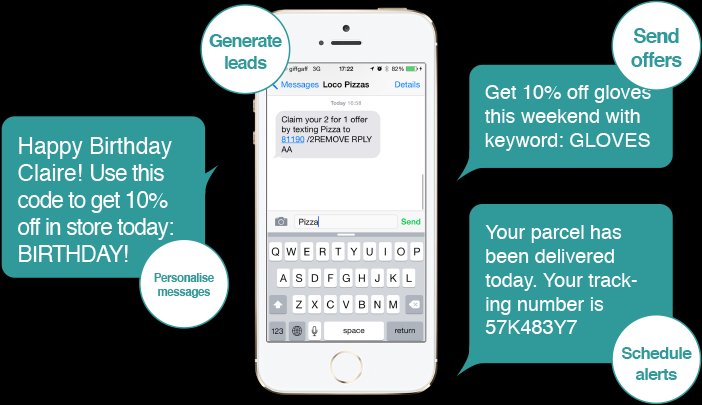
Even though the popularity of email has skyrocketed since SMS was introduced, it has not reduced SMS popularity. SMS continues to have certain advantages over email. Emails are only opened 20-30% of the time while on average SMS is opened 98% of the time, and 90% are opened within 3 seconds. For certain use cases like two-factor authentication (2FA) SMS is the standard and does not look like it is going away any time soon.
One of the key reasons for this is that unlike modern messaging apps, which require the consumer to send the first message to the business before a conversation can begin, SMS allows companies to send messages to any person as long as they have the phone number available.
The Limitations of SMS & Rise of Messaging Apps
The same characteristics that have made SMS globally ubiquitous and universal have allowed the SMS protocol do become outdated compared to other forms of messaging.
SMS is limited to 160 characters, so it is unable to send long messages not to mention media such as images, videos, and files. Although carriers have attempted to add this capability using Multimedia Messaging Service (MMS) standard, these efforts have never achieved the ubiquity of SMS.
Another major drawback is the end-users inability to receive SMS when they not on a cellular connection. With an ever more global world, messaging apps that can send and receive over wifi make the risks of SMS roaming fees even less desirable to the consumer.
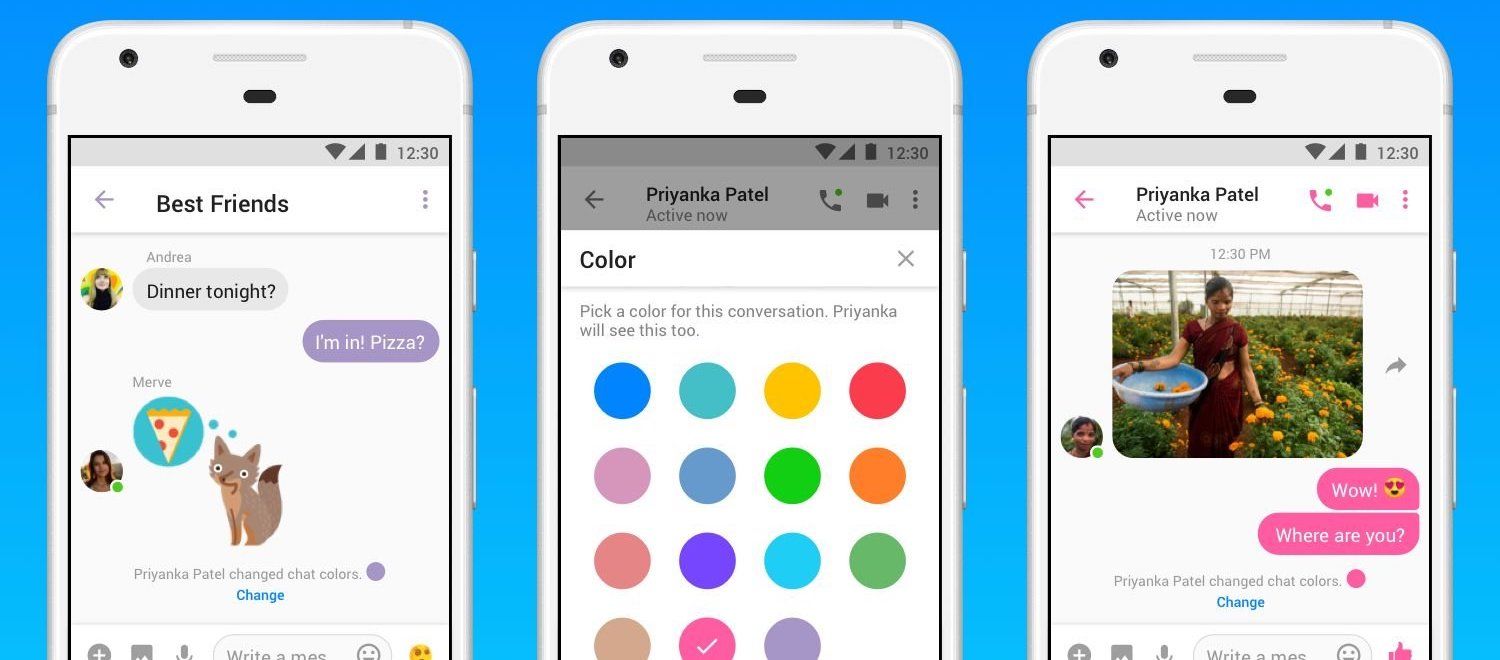
The weaknesses of SMS have led to the stupendous rise of messaging app services all around the world. With Facebook Messenger, WhatsApp & WeChat becoming the top 3 most popular messaging apps globally while a set of smaller competitors continues to battle it out with the goliaths in their respective niches.
Although all these messaging apps have features to differentiate themselves from each other and to fulfill the needs of their primary geographic audiences, they have a common set of features that SMS lacks. These include image sharing, video chat group chat, and stickers which SMS do not have.
In an age where even Mark Zuckerberg professes that sharing is moving from social media to private messaging, competing in a messaging world makes having the ability to share dank memes with your friends a must-have rather than a nice to have.
For businesses though, dank memes are secondary. The rise of messaging apps has created two critical issues for businesses, especially global ones. The first is a fragmented landscape, moving from an SMS a single protocol to several messaging apps is tricky. The second is opt-in, messaging app companies requires the end consumer to send the first message, meaning collecting emails and phone numbers at check out is no longer enough.
Turn customer conversations into business growth with respond.io. ✨
Manage calls, chats and emails in one place!
What is RCS Messaging?
Now that we've discussed the benefits and limits of SMS as compared to messaging apps. Let's see if RCS Messaging is going to be able to bridge the gap.
Carriers Try To Replace SMS to RCS
What is RCS Messaging? The idea of Rich Communication Services (RCS) was first launched in 2007 by a group of telecom industry representatives using the GSM Association to form a steering committee. It was intended as an upgrade to existing SMS infrastructure. Its value proposition was to enable to send rich messages like those found in messaging apps but still pass through an inter-carrier network, just like SMS.

The backing of GSMA was supposed to be a big boost to the RCS Messaging effort. It is the association that represents the interests of mobile network operators worldwide with 800 members and 300 associate members. On paper, this was the organization that was supposed to make RCS messaging take off.
The main culprit for the slow development of the RCS messaging around this time was carrier politics. Although carriers were very much interested in the standard for the purposes of protecting carrier control of the messaging infrastructure, they were not interested in making the upfront investment necessary to support the standard, especially since when other competing networks hadn't done the same.
Google Backs RCS Messaging
In 2012, global SMS revenues hit a peak. At around the same time, Google was fresh off a string of failures in messaging. Google wanted to continue to push into messaging, especially because of the success of iMessage, but also wanted to keep both carriers and OEMs happy. So in 2016, Google joined in promoting RCS as the messaging standard of the future.
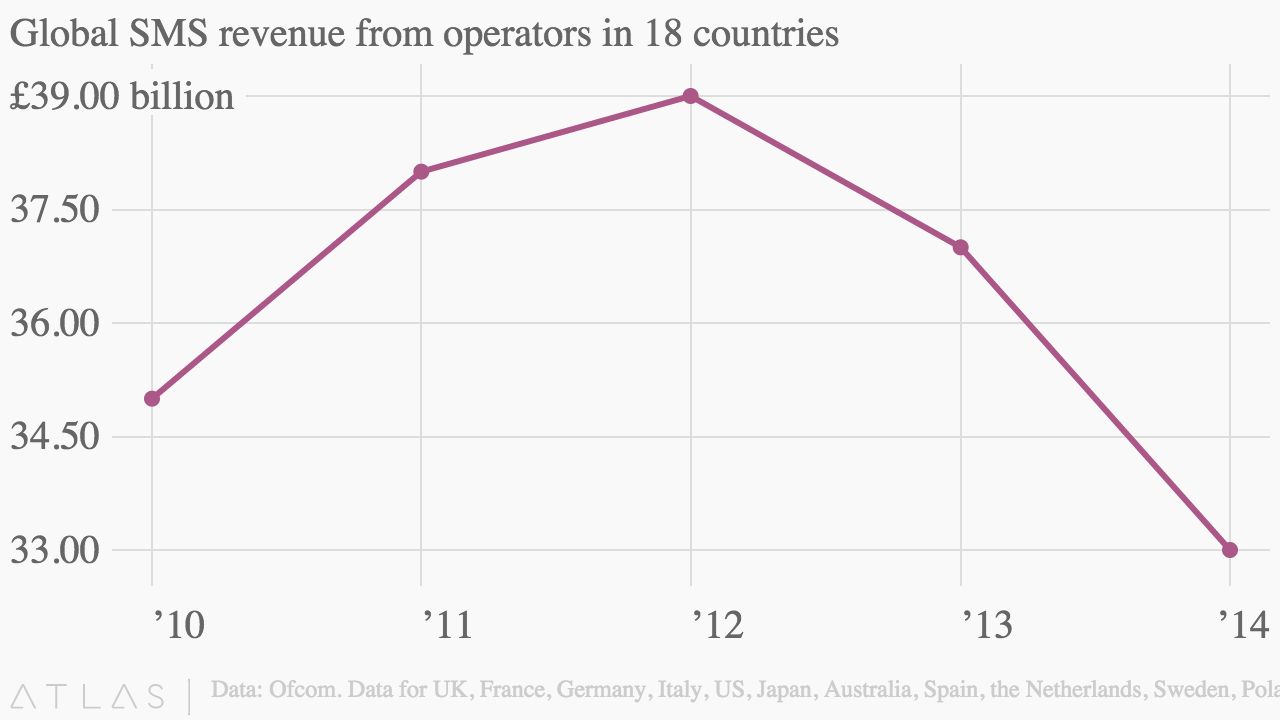
Google decided to partake in the development as they want to take to their own hands the release of RCS messaging. Google’s involvement kickstarted a lot of RCS Messaging development and have reported that it is working with every major cell carrier to adopt the RCS messaging protocol.
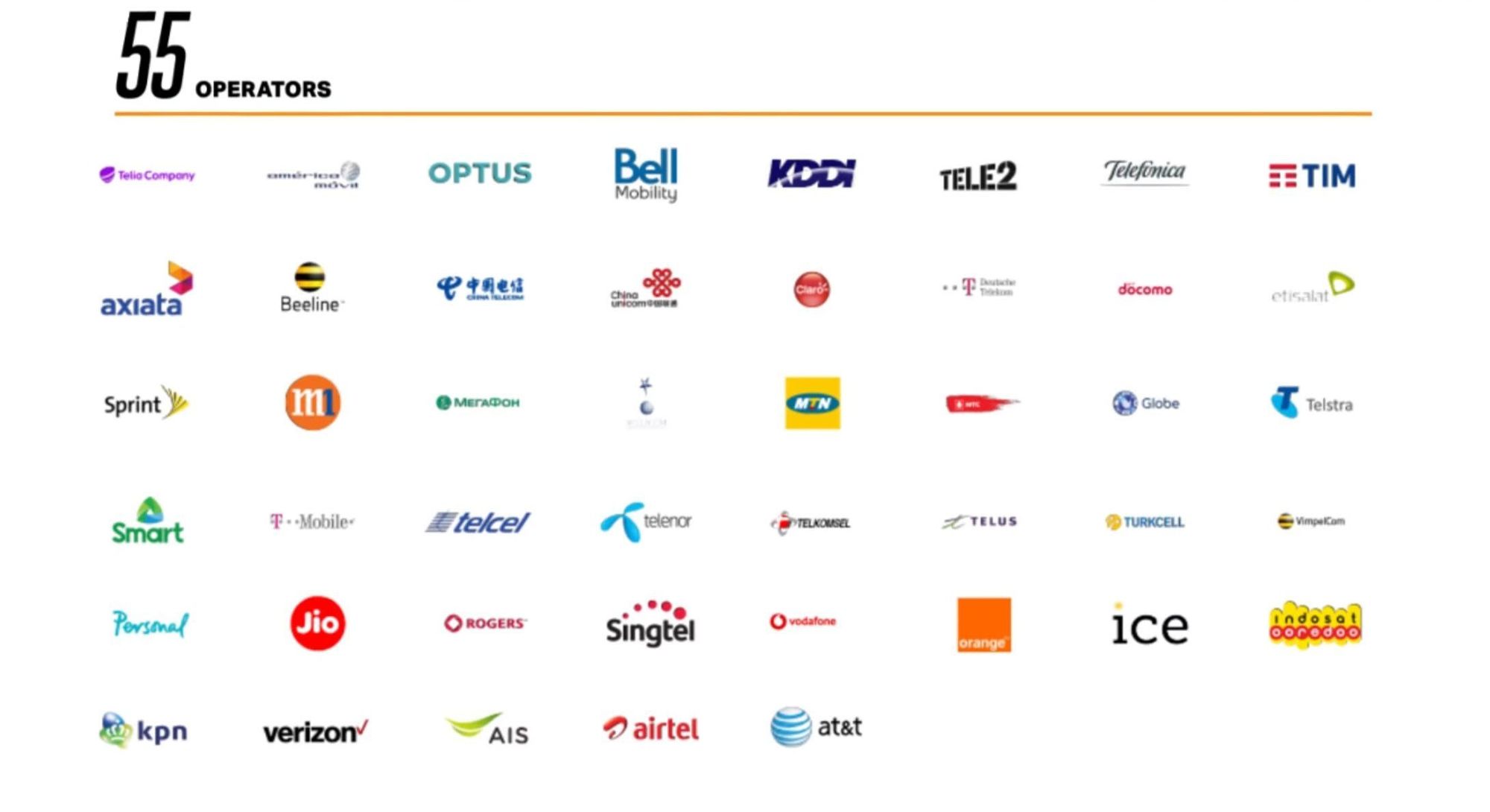
To make an RCS messaging brand for consumers, Google has confusingly branded the RCS messaging protocol as Chat. Chat includes the features that messaging apps have such as group chat, video and audio messages, high-resolution images, read receipts, typing indicator, money transfer, and location sharing making it closer to iMessage and other chat applications.
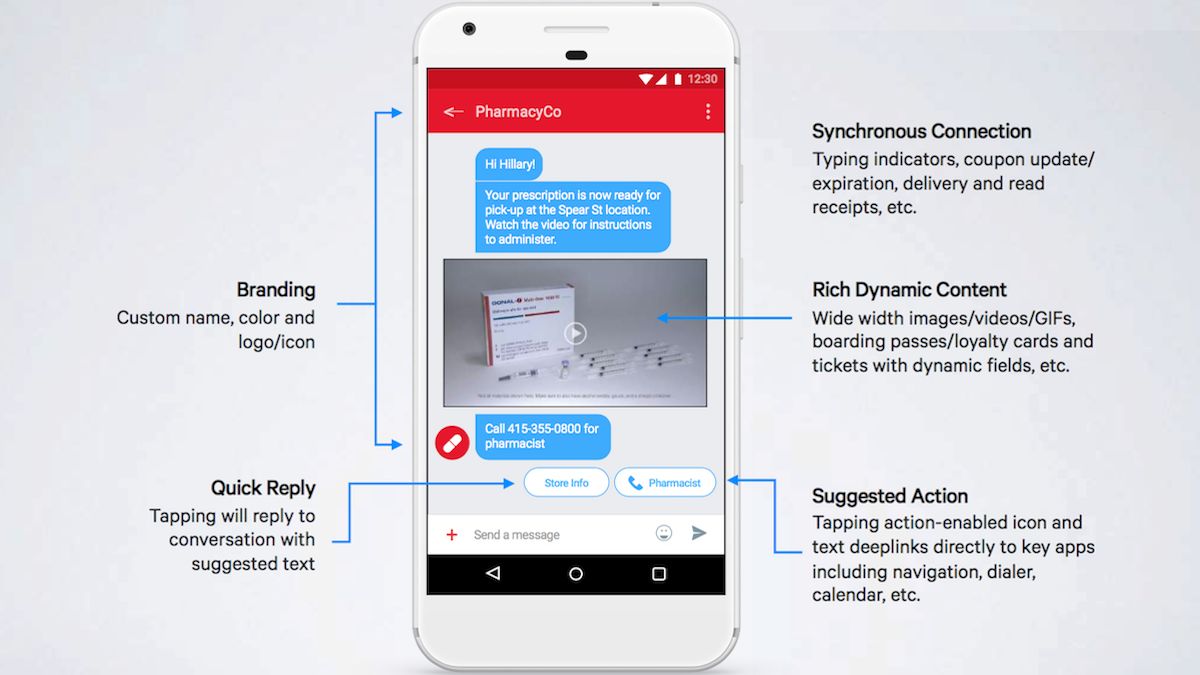
Google Enables Carriers To Switch To RCS Messaging
For the foolproof functioning of RCS Messaging, it needs to be enabled on the end-users phone and must be enabled on both the sending and receiving carriers network.
Although there isn’t a dedicated RCS Messaging app, it is fully supported by Androids default messaging app messages. Currently, most Android OEMs ship with Messages as the default SMS app, with Samsung being a notable exception. Google started to deal with this issue in 2018 when it announced that it was working with Samsung to ensure Samsung messages could support RCS Messaging out of the box.
RCS Messaging uses SMS as a backup to ensure RCS message delivery. As a sender starts typing a message, the Android device will ping the recipient to determine whether they have RCS messaging support. If the user does not have RCS messaging support, the message will be sent as an SMS.

Another critical aspect of the success of the RCS Messaging protocol is to ensure that carriers support the protocol. Google has been working with 55 carriers to provide support for RCS Messaging. Although all 55 carriers support RCS Messaging in one form or another, the most significant remaining challenge is to make sure all carriers support the most updated standard of RCS Messaging called the Universal Profile.
Instead of just letting carriers figure it out in their own, Google has created an infrastructure as a service company to support the rollout of the universal profile. Google has done this through the acquisition of Jibe Mobile; a cloud-based solution to the RCS Messaging than carriers can implement quickly.
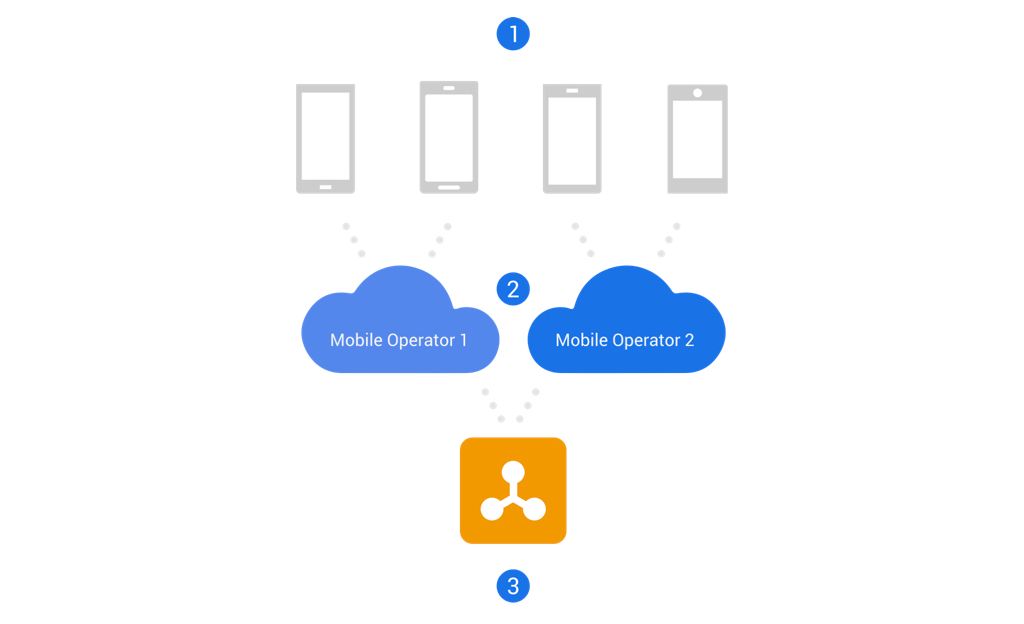
Currently, Google is testing RCS Messaging services in the UK and France. Customers can opt-in to RCS Messaging without waiting for carrier support. Once Google has successfully tested RCS Messaging in the UK and France, all Android phones around the world could get the same feature.
The RCS Messaging protocol will need some time to mature and reach full proliferation, and this may take some time. Unlike the highly successful iMessage, the RCS Messaging protocol ties communication to a phone number and depends on the carriers to deliver the message. The RCS messaging protocol is designed so that no one company can control the whole system. This is also what hampers its worldwide rollout and growth in popularity.
Using RCS Messaging For Business
It may seem that RCS Messaging has a long road towards adoption, Google is accelerating the timeline by making RCS Messaging the perfect business chat solution.
Google is providing businesses the same characteristics they expect with SMS messaging; broad reach and reliable deliverability. While delivering the same UI features, end users have grown to expect in messaging apps.
RCS Messaging vs SMS: Better for Business?
If you are looking for reachability and deliverability, SMS is the ultimate solution. It's simple, take your customer list, upload it to an SMS broadcasting tool and send out things like Two Factor Authentication and other notifications. Since every phone supports SMS, delivery is guaranteed.
However, SMS functionality is missing a lot. Things like sending images and videos are essential features to an end-user but are not always possible with SMS. Part of the appeal of RCS Messaging to companies is that its rich UI satisfies the expectations of end-users.

RCS Messaging is built from the ground up to allow businesses to send customers high-quality images and videos. Completely removing the fragmentation issues that SMS had when working with the carriers specific Multimedia Messaging Protocol. (MMS)

RCS Messaging is better for delivering live chat style support too. Although SMS already had delivery receipts, RCS Messaging takes this to the next level with a typing indicator. Letting customer service staff know that there is more coming.

An advantage Messaging Apps have over SMS is that they have enabled support for use case-based templates that deliver information in an optimized format.
Thankfully RCS Messaging has also implemented use case-based UI templates that enable businesses to deliver information in a use case optimized format.
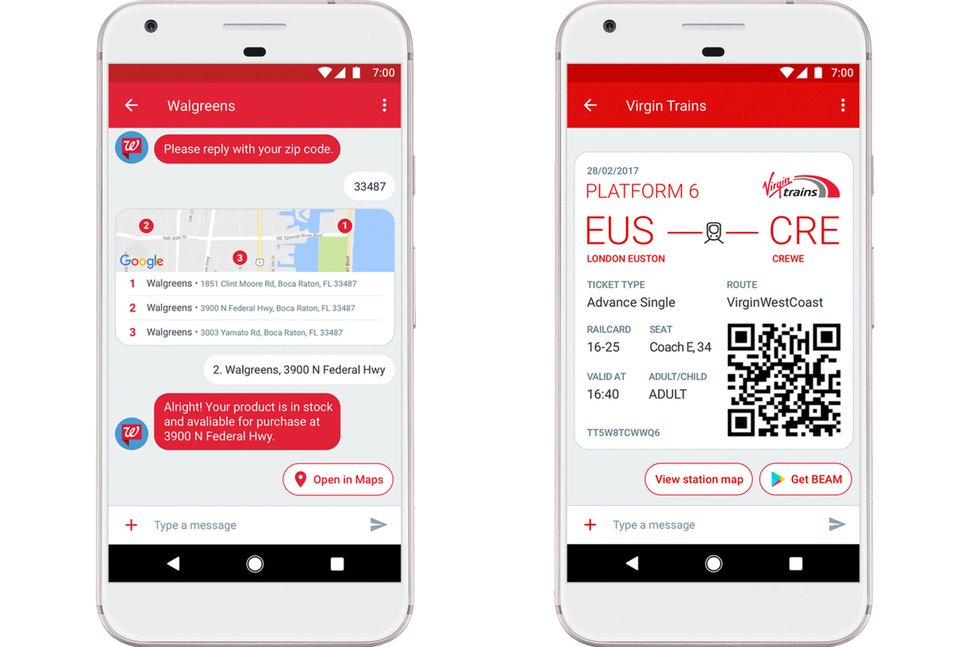
Last but certainly not least, one of the best features of RCS Messaging for business is the ability to brand the chat. Unlike SMS, which can not display the brand's name unless you add them as a contact, RCS Messaging will display the company brand name by default. RCS Messaging even allows you to change the colors of the chat interface based on your brand colors.
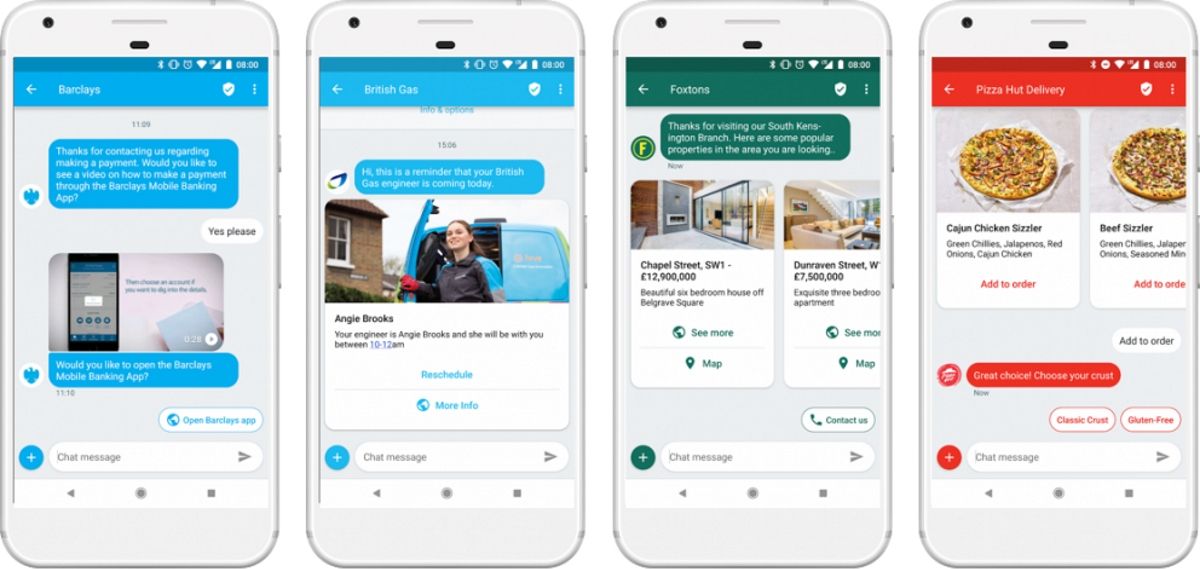
The Business Account branding feature takes RCS Messaging a step above what Messaging Apps can provide. Although Messaging Apps do allow companies to use their brand name in the chat, they do now allow businesses to change the colors of the chat UI, that is unique to RCS Messaging.
RCS Messaging vs Messaging Apps: Better for Business?
There are many benefits of using Messaging App business accounts over SMS. On Facebook Messenger, companies can use click to chat ads or convert website visitors into Facebook Page Messaging Connections. There are additional benefits as well. Since most Messaging Apps do not charge a fee to send messages back and forth to customers, they are cheaper use than SMS. However, like any business tool, there are drawbacks as well.
Compared to SMS, the audience on Messaging Apps is fragmented. There are about seven very popular messaging apps around the world, three of them have most of the market share. This makes it hard for businesses to find all their customers in one place.
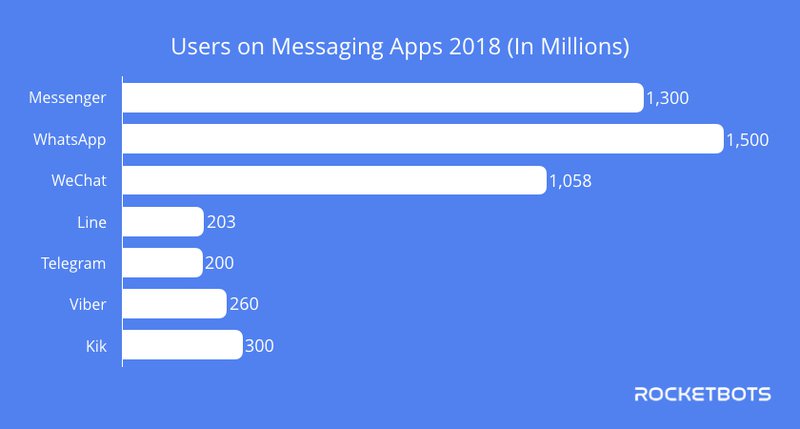
Another issue with messaging apps is that businesses cannot generally send the first message. This is unlike SMS, where as long as you have the number, you can technically send the first message. Could RCS Messaging be the channel the blends both the reachability and deliverability of SMS while providing the rich UI users expect from Messaging Apps?
In short, with Google's help, RCS Messaging can become a ubiquitous channel for business to consumer communications if Google can get all carriers onboard with an RCS Messaging Protocol of the same standard.
With universal support, RCS Messaging would provide the benefits of SMS, meaning businesses would be able to send the first message and be confident that all their customers are available on the same platform. While at the same time, with the UI features available in RCS Messaging end users would have the features they have become accustomed to on Messaging Apps.
Companies Are Already Using RCS Messaging
As with any upcoming product, there are early adopters of the protocol. Companies like 1-800 Flowers who was an early adopter of Facebook Messenger and WhatsApp Business API has been one of the first to take the leap.
Taking Orders Over RCS Messaging: 1-800-Flowers
1-800-Flowers, retails and distributes flowers and gourmet food, is one of the first business to integrate RCS Business Messaging. With the UI templates and elements available with the protocol, 1-800-Flowers built the same carrousels and booking dialogs they have already created in Facebook Messenger. This allows customers to browse products, select optional extras and check out, all without visiting a website or downloading a messaging app.

Billing & Collections On RCS Messaging: Total Play
Another business example comes from a Mexican telecom, Total Play; they offer subscription television, landline telephone, fiber optic internet connection, and cellular data. They started implementing RCS messaging as they have problems with collecting payment whether it is almost due or past due. Total Play normally would send a text message to each user reminding them of the balance and payment. They experienced that SMS has low engagement and without the read receipt there is no way of knowing whether their customer has received and read the message.

They can send monthly reminders which include balances and due dates and customers can immediately act right there and then in the messaging app. RCS messaging has enabled Total Play customers to add debit/credit card for automatic payments, be redirected to the payment webpage, request account, and balance information, as well as reach a customer representative through phone or chat. This solution has been effective for Total Play as they can increase response and enhance customer support. Their response rate has increased by 78% and on-time bill payment increased by 65%.
The Future of RCS Messaging
RCS Messaging will only succeed if Google and carrier partners can implement the universal profile of RCS Messaging around the world and create one complete audience for companies to be able to reach out to. Before the protocol can achieve this mission, there are some issues to resolve. The protocol will have to deal with issues like end-to-end encryption, carrier support, business adoption, and user adoption.
Future of RCS: Encryption
End-to-end encryption is important to users and most major chat applications such as iMessage and WhatsApp do have end-to-end encryption. Google claims that they are working on private chat on RCS messaging protocol and said that they do not keep messages as they passes through their server and delete message that are queued.
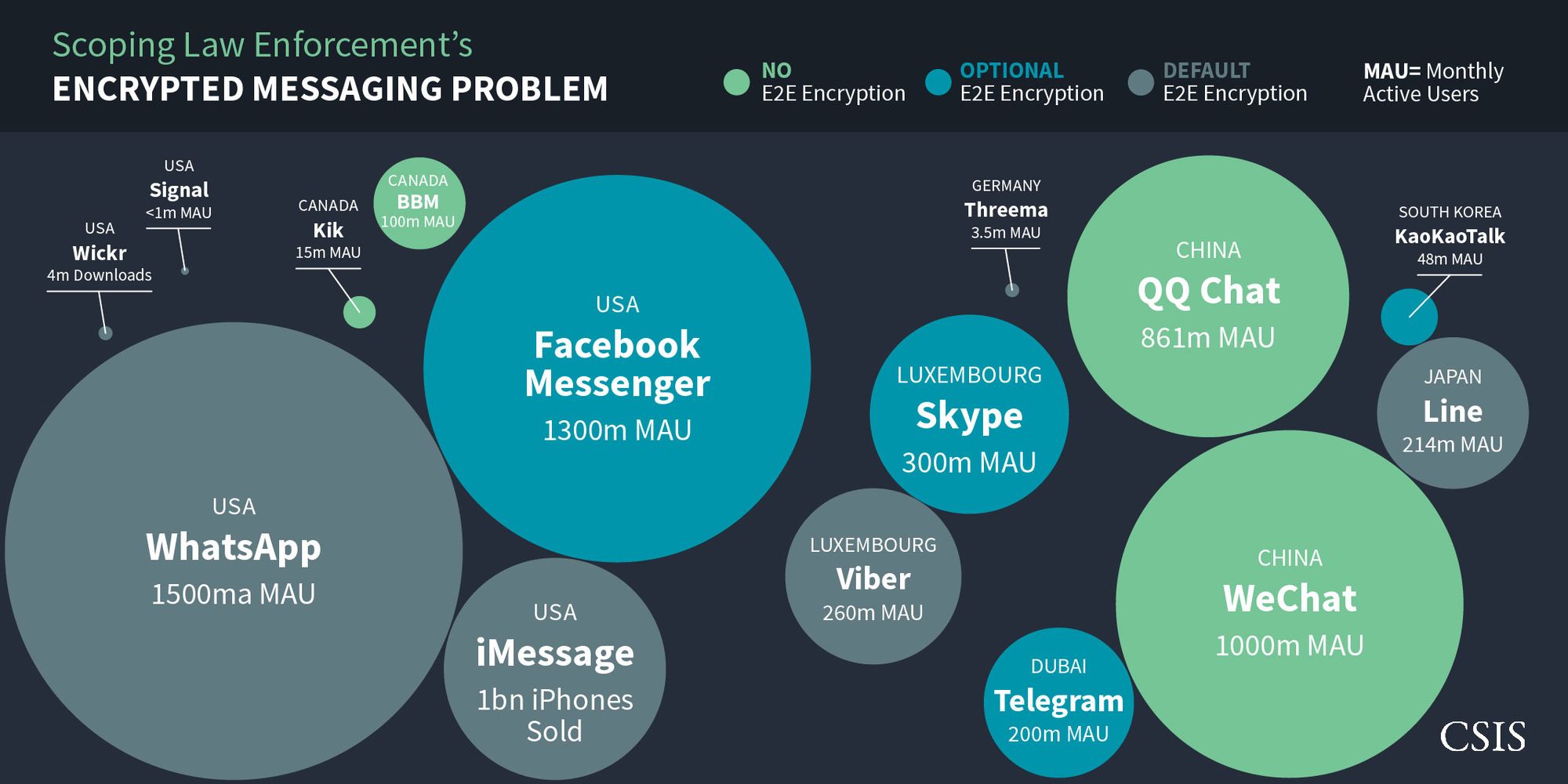
However, this is largely a moot point because RCS Messaging is not end to end encrypted. These messages that are sent and received move in an encrypted format until they are passed to the carriers servers.
Future of RCS: Carrier Adoption
Another issue with carriers is adoption. Although many have adopted an RCS Messaging standard, not all have implemented the universal profile required to support modern day RCS. This means network depending a message may arrive as RCS or fallback to the SMS standard.
This gets more complicated when carriers selectively support RCS messaging. T-mobile RCS Messaging supports most phones except for the Pixel 3A. Which is ironically a Google phone.
Future of RCS: User Adoption
The biggest question with user adoption of RCS Messaging is why end-users would switch to RCS in the first place. The biggest factor for the success social platform whether it be open or closed is social interaction. For end-users to push for the adoption of RCS it would have to offer something that is currently not available on other platforms.

With social platforms under increased scrutiny regarding security RCS doesn't seem to have an answer, with existing platforms like iMessage offering E2E encryption. Apple was able to maintain a privacy-first image and WhatsApp has too. It would be difficult to envision a world where users switch to RCS based on privacy concerns.
Features could be a reason that switch, but if we look at the messaging app world, we can see it is very difficult to generate market share based on features alone. The most successful case is LINE. By focusing only on its primary markets of Indonesia, Thailand, Taiwan, and Japan, they have designed a chat application that fits local markets.

Based on what we have seen so far, we think it is unlikely that users will drive the popularity of the RCS Messaging protocol.
Future of RCS: Business Adoption
From our perspective, it seems like the success or failure of the RCS Messaging protocol will depend on business adoption. RCS Messaging is shaping up to become the ultimate messaging app for business. It has four critical characteristics that neither messaging apps or SMS can muster on their own.
Reachability. Unlike messaging apps, with just a phone number businesses will be able to send the first message to their customers.
Fragmentation. It is unlikely that you'll be able to reach out to all your customers on just a single messaging app. By using phone numbers and working in a similar way to SMS, RCS has the potential to enable a business to access any person in the world.
User Experience. RCS provides the rich UI businesses need to deliver information in a compact easy to read format like lists, carousels, use case based templates and quick replies.
Business Account Branding. No other option provides the level of business branding that RCS does. Allowing Businesses to use their colors and logos in the chat is sure to make CMOs everywhere smile.
Turn customer conversations into business growth with respond.io. ✨
Manage calls, chats and emails in one place!
Further Reading
If you enjoyed reading this article and would like to learn more about business messaging we recommend that you read our Ultimate Guide to Messaging Apps for Business.






































 Electronics
Electronics Fashion & Apparel
Fashion & Apparel Furniture
Furniture Jewelry and Watches
Jewelry and Watches
 Afterschool Activities
Afterschool Activities Sport & Fitness
Sport & Fitness
 Beauty Center
Beauty Center Dental Clinic
Dental Clinic Medical Clinic
Medical Clinic
 Home Cleaning & Maid Services
Home Cleaning & Maid Services Photography & Videography
Photography & Videography
 Car Dealership
Car Dealership
 Travel Agency & Tour Operator
Travel Agency & Tour Operator




